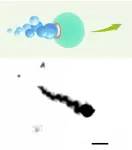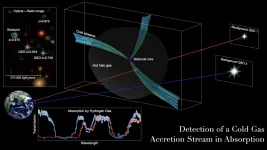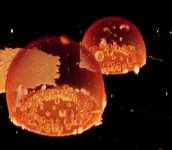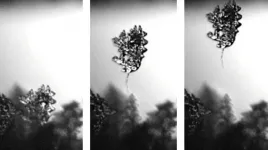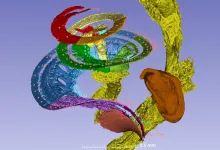Can polar bears and narwhals cling on as the ice shrinks?
2021-02-24
(Press-News.org) As part of the Journal of Experimental Biology's Special Issue dedicated to climate change, Anthony Pagano (San Diego Zoo Global, USA) and Terrie Williams (University of California, Santa Cruz, USA), discuss the impact of environmental change on two iconic polar species; the polar bear and narwhal. Their review article is published in Journal of Experimental Biology at https://jeb.biologists.org/content/224/Suppl_1.
Mammals in the Polar Regions face an uncertain future as unprecedented warming drives catastrophic sea ice loss, driving polar bears onto land, after losing access to sea ice and the highly calorific seals upon which they feed, forcing the animals to depend on lower calorie diets. The scientists say, 'A polar bear would need to consume approximately 1.5 caribou, 37 Arctic char, 74 snow geese, 216 snow goose eggs (i.e.54 nests with 4 eggs per clutch) or 3 million crowberries to equal the digestible energy available in the blubber of one adult ringed seal'. They add, 'Few resources exist on land within the polar bears' range that could compensate for declines in seal feeding opportunities'.
Pagano and Williams have measured the energetic cost of movement for narwhals and polar bears and found that major ice loss translated into elevated locomotor that are 3- to 4-fold greater than expected when sea ice cover is normal. This increase in energy consumption, coupled with the loss of access to the polar bear's main food source leaves them particularly vulnerable to starvation.
The scientists also consider how the high costs of diving for narwhals, coupled with the loss of reliable breathing holes upon which they depend, due to unpredictable sea ice shifts, have led to the mammals becoming trapped beneath the ice. The narwhal's slow swimming paces also leaves them vulnerable to attacks by killer whales open water.
The scientists warn that the decline of both apex predators will 'lead to rapid changes in the Arctic marine ecosystem'.
INFORMATION:
IF REPORTING THIS STORY, PLEASE MENTION JOURNAL OF EXPERIMENTAL BIOLOGY AS THE SOURCE AND, IF REPORTING ONLINE, PLEASE CARRY A LINK TO: https://jeb.biologists.org/content/224/Suppl_1/jeb228049
Reference: Physiological consequences of Arctic sea ice loss on large marine carnivores: unique responses by polar bears and narwhals, by Pagano, A.M. and Williams, T.M. (2021). J. Exp. Biol. 224, jeb228049.
Doi: 10.1242/jeb.228049.
This article is posted on this site to give advance access to other authorised media who may wish to report on this story. Full attribution is required, and if reporting online a link to jeb.biologists.com is also required. The story posted here is COPYRIGHTED. Therefore advance permission is required before any and every reproduction of each article in full. PLEASE CONTACT permissions@biologists.com
THIS ARTICLE IS EMBARGOED UNTIL WEDNESDAY, 24 FEBRUARY 2021, 8:00 HRS EST (13:00 HRS GMT)
ELSE PRESS RELEASES FROM THIS DATE:
2021-02-24
Rheumatoid arthritis is a chronic inflammatory disorder marked by joint pain, swelling and damage. Although medications, such as steroids, anti-inflammatory drugs and immunosuppressants, can help slow joint destruction and relieve pain, they have side effects and aren't completely successful. Now, researchers reporting in ACS' Nano Letters have developed magnesium-based micromotors propelled by hydrogen bubbles, which improved rheumatoid arthritis symptoms when injected into the joints of rats.
Scientists have linked rheumatoid arthritis development to the excess production of reactive oxygen species (ROS). ROS can oxidize and degrade cartilage and bone, as well as activate the expression of inflammatory cytokines. A new type of therapy, hydrogen gas, can neutralize ROS ...
2021-02-24
To come into being, galaxies need a steady diet of cold gases to undergo gravitational collapse. The larger the galaxy, the more cold gas it needs to coalesce and to grow.
Massive galaxies found in the early universe needed a lot of cold gas--a store totaling as much as 100 billion times the mass of our sun.
But where did these early, super-sized galaxies get that much cold gas when they were hemmed in by hotter surroundings?
In a new study, astronomers led by the University of Iowa report direct, observational evidence of streams of cold gas they believe provisioned these early, massive galaxies. They detected cold gas pipelines that knifed through the hot atmosphere in the dark matter halo of an early massive galaxy, supplying the materials ...
2021-02-24
New research by the University of Oslo provides evidence that the "protocells" that formed around 3.8 billion years ago, before bacteria and single-celled organisms, could have had specialized bubble-like compartments that formed spontaneously, encapsulated small molecules, and formed "daughter" protocells.
ROCKVILLE, MD - Scientists have long speculated about the features that our long-ago single-celled ancestors might have had, and the order in which those features came about. Bubble-like compartments are a hallmark of the superkingdom to which we, and many other species including yeast, belong. But the cells in today's superkingdom have a host of specialized molecules that help make and shape these bubbles inside our ...
2021-02-24
ATLANTA - FEBRUARY 24, 2021 - New study reports that early in the 2020 pandemic in the United States, one-third of cancer survivors worried about treatment and cancer care disruptions. Using a mixed methods approach, investigators utilized survivors' own words to more deeply describe their experiences and worries about the pandemic's impact on their overall health.
The article, appearing in the Journal of Psychosocial Oncology, finds the impact of the pandemic on cancer survivors and the broader health care system is widespread and exacerbated serious gaps in the health care system. For this study, investigators led by Corinne Leach, MPH, MS, PhD, from the American ...
2021-02-24
If you have ever gotten up on a winter morning and thrown yourself into the arduous task of scraping frost from a windshield, a Virginia Tech lab is engaging science [IS1] that could make your life much easier. In research funded by the National Science Foundation, Associate Professor END ...
2021-02-24
DALLAS, Feb. 24, 2021 -- Postmenopausal women who ate high levels of plant protein had lower risks of premature death, cardiovascular disease and dementia-related death compared with women who ate less plant proteins, according to new research published today in the Journal of the American Heart Association, an open access journal of the American Heart Association.
Previous research has shown an association between diets high in red meat and cardiovascular disease risk, yet the data is sparse and inconclusive about specific types of proteins, the study authors ...
2021-02-24
In the largest genome-wide association study of glaucoma comparing the genes of 34,179 people with the disease to 349,321 control subjects, an international consortium of researchers identified 44 new gene loci and confirmed 83 previously reported loci linked to glaucoma. Loci are considered "genetic street addresses," denoting a specific location on a gene.
The study's authors hope the identification of these genes will lead to new treatment targets for this incurable eye disease that is a leading cause of blindness worldwide.
"These new findings come out of the highest-powered genome-wide association study of glaucoma to date, and show the power of team science and using big data to answer questions when research groups around the world join forces," said co-senior study author ...
2021-02-24
Peer review/Experimental study/Cells
Researchers at Uppsala University have created the first 3D map of the hearing nerve showing where the various sound frequencies are captured. Using what is known as synchrotron X-ray imaging, they were able to trace the fine nerve threads and the vibrating auditory organ, the cochlea, and find out exactly how the frequencies of incoming sound are distributed. The study is published in Scientific Reports.
"This can make treatment with cochlea implants for the hearing-impaired more effective," says Helge Rask-Andersen, Professor of Experimental Otology at Uppsala ...
2021-02-24
Genome variation data on more than 7,000 malaria parasites from 28 endemic countries is released today (24 February) in Wellcome Open Research. It has been produced by MalariaGEN, a data-sharing network of groups around the world who are working together to build high-quality data resources for malaria research and disease control.
This open data release represents the world's largest resource of genomic data on malaria parasite evolution and drug resistance. It provides benchmark data on parasite genome variation that is needed in the search for new drugs and vaccines, and in the development of surveillance tools for malaria control and elimination.
Malaria is a major global ...
2021-02-24
In the journal Nature Communications, scientists of the German Center for Neurodegenerative Diseases (DZNE) report new findings on the mechanisms of "Niemann-Pick type C disease" (NPC). This rare brain disorder mainly manifests in childhood and includes severe neurological and psychiatric symptoms. Researchers led by Dr. Sabina Tahirovic have now found evidence that already at an early stage, NPC is associated with neuroinflammation and that this condition is triggered by impaired intracellular lipid transport. In addition, they identified pathological features in the blood of affected individuals that in the future could assist to better monitor the course of the disease and response to therapy.
NPC is a hereditary metabolic disorder ...
LAST 30 PRESS RELEASES:
[Press-News.org] Can polar bears and narwhals cling on as the ice shrinks?
